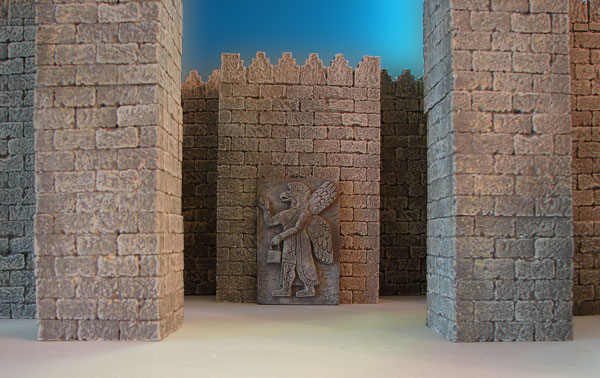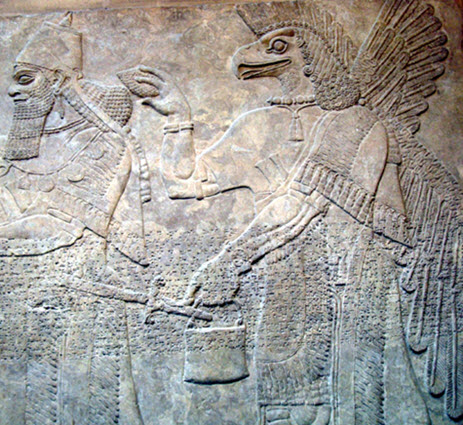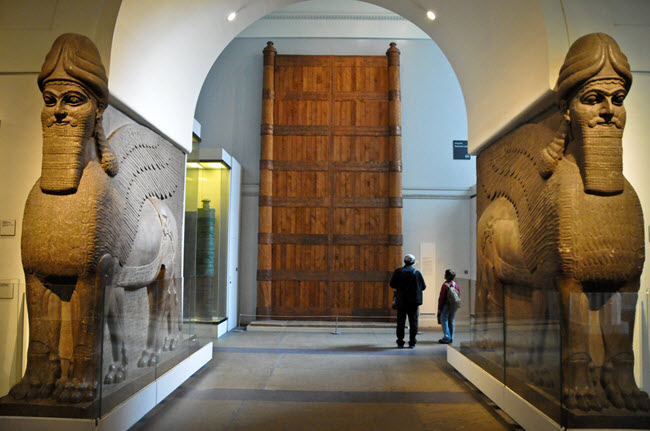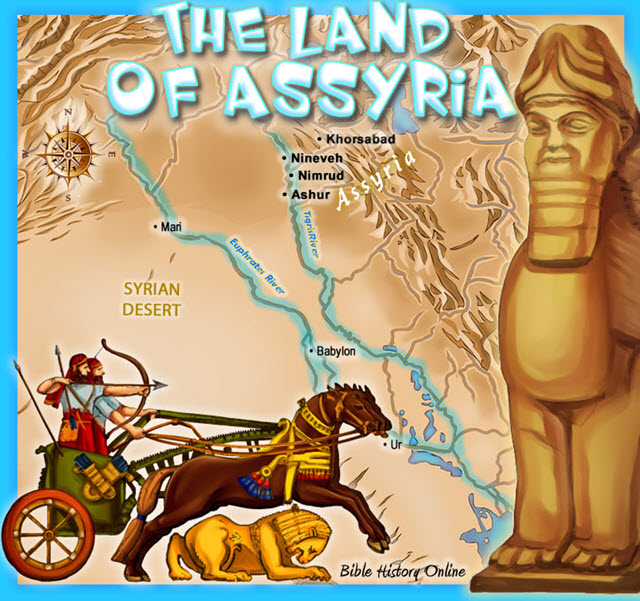|
|
This miniature replica is of the Eagle Headed Winged Genie of Assyria, from the Palace of Sargon II. Many scholars believe that this is Nisroch who is mentioned in the Bible in connection with king Sennacherib. The panel was discovered at the site of ancient Nimrud during the reign of Ashurnasirpal (885-860 BC). The original is located at the British Museum. 2 Kings 19:36-37 - So Sennacherib king of Assyria departed, and went and returned, and dwelt at Nineveh. And it came to pass, as he was worshipping in the house of Nisroch his god, that Adrammelech and Sharezer his sons smote him with the sword: and they escaped into the land of Armenia. And Esarhaddon his son reigned in his stead.
Museum Images
- Sculpture of an eagle headed protective
winged spirit 2 Kings 19:35-37 - "And it came to pass that night, that the angel of the LORD went out, and smote in the camp of the Assyrians an hundred fourscore and five thousand: and when they arose early in the morning, behold, they [were] all dead corpses. So Sennacherib king of Assyria departed, and went and returned, and dwelt at Nineveh. And it came to pass, as he was worshipping in the house of Nisroch his god, that Adrammelech and Sharezer his sons smote him with the sword: and they escaped into the land of Armenia. And Esarhaddon his son reigned in his stead. Interesting Note: An Assyrian scribe claimed that one of the reasons for the death of Sennacherib was that a Lamassu fell on him because of his impious deeds. Sennacherib was the Assyrian king who lost his army attacking Jerusalem, destroyed by the "Angel of the LORD."
The Winged Spirit Eagle Headed Winged Spirit This winged eagle-headed figure is a classic Assyrian type of protective magical spirit, and great numbers of such figures decorated the palace.The Sacred Tree was extremely common in magical sculptures of Ashurnasirpal's reign, and probably represented the fertility of the land which the magical figure was protecting. Parpola (1993) has maintained that it acquired great esoteric significance in Mesopotamian religious thought. Limestone wall-relief depicting an Eagle
Headed Genii and tree: he wears a kilt with long tassels hanging from
it, and a fringed robe, and has two daggers and a whetstone in his belt.
The cone in his right hand is described in Assyrian texts as a purifier,
and was presumably envisaged as being covered in liquid from the bucket
in his left hand. The cone may derive its shape from the male date-spathe,
used to fertilise female date-palms.On the right is half a Sacred Tree,
again a symbol of great importance in Assyria. The trunk has a large
palmette at its top, and a network of palmettes surrounding it, only
half of which are preserved on this piece. Around the trunk are three
sets of horizontal binding, each supporting hornlike growths and
volutes, and a chevron pattern runs up it. Part of the standard
inscription is preserved above the scene. The Winged Genie Supernatural spirits and a sacred tree
The first great military empire in ancient history was the Assyrian Empire. By the time of Ashurnasirpal and Shalmaneser III in the 9th century BC the Assyrians organized a mighty army of nearly 200,000 soldiers. Their military strategy was unsurpassed up to that time, and with the age of iron they were an unstoppable fighting machine. They brought spearmen, archers, shieldmen, slingers, siege engines, chariots, and a huge calvary into the battlefield. The mighty Assyrians dominated the ancient world until they were crippled by the God of Israel in the reign of Sennacherib. God raised up the Assyrians to remove Israel out of his sight for their rebellion and idolatry, but the Assyrians would also be punished also for their wicked ways. They finally fell to the Medes and Babylonians in 612 BC and passed into history.
2 Kings 15:29 - In the days of Pekah king of Israel, Tiglath Pileser king of Assyria came and took Ijon, Abel Beth Maacah, Janoah, Kedesh, Hazor, Gilead, and Galilee, all the land of Naphtali; and he carried them captive to Assyria. 2 Kings 15:19 - Pul the king of Assyria came against the land, and Menahem gave Pul one thousand talents of silver, that his hand might be with him to confirm the kingdom in his hand. 2 Kings 18:9 - And it came to pass in the fourth year of king Hezekiah, which [was] the seventh year of Hoshea son of Elah king of Israel, that Shalmaneser king of Assyria came up against Samaria, and besieged it. Isaiah 20:1 - In the year that Tartan came unto Ashdod, when Sargon the king of Assyria sent him,) and fought against Ashdod, and took it; 2 Kings 19:16 - LORD, bow down thine ear, and hear: open, LORD, thine eyes, and see: and hear the words of Sennacherib, which hath sent him to reproach the living God. 2 Kings 19:37 - And it came to pass, as he was worshipping in the house of Nisroch his god, that Adrammelech and Sharezer his sons smote him with the sword: and they escaped into the land of Armenia. And Esarhaddon his son reigned in his stead. Ezra 4:10 - and the rest of the nations whom the great and noble Asnapper brought over, and set in the city of Samaria, and in the rest of the country beyond the River, and so forth, wrote. Assyrian Kings Names in Cuneiform Archaeology of Ancient Assyria Timeline of Ancient Assyrian Kings (During the Period of the Biblical Kings)
Assur-nasirpal II (885-860
B.C.) A cruel warrior king, he made Assyria into the most fierce
fighting machine of ancient world.
For More Info See: Bible History Online
The Assyrian Annals. The scribes of the chief cities of the Assyrians wrote the accounts of the king's military campaigns on cuneiform tablets, and clay prisms or cylinders. The accounts are very reliable, even though the accounts do not speak negatively of the Assyrians and are meant to glorify the king. The annals also give much detail to geography and Chronology. It is interesting how accurate the Assyrians were with dates, they made use of an Assyrian Kings List or the Eponym Canon. The Assyrian Chronicles and Eponym Canon. The Assyrian scribes organized their national events whether military, political or religious every regnal year. The Babylonian Chronicles were structured the same way. Assyrian records were kept very carefully, they took their dating and their history seriously. They attached their record of events with the solar year and with the name of an official who was known as the "limmu." Their was a new limmu appointed every year. They recorded military, political and religious events in every year and made references to eclipses. The Assyrian records are highly dependable and allow Biblical scholars a very accurate way of dating events and designating "eponyms" for 244 year in Hebrew history, from 892-648 BC.
The Assyrian King List.
The Assyrian King List reveals a list of the kings of ancient
Assyria in chronological order, from the 2nd millennium BC to 609 BC. It
lists the name of the king, his father's name, the length of his reign,
and some great achievements. The Bible. The Old Testament records the history of the Kingdoms of Israel and Judah, along with the battles of other nations. It includes the fall of the 10 tribes in northern kingdom of Israel in 722 BC by the Assyrians, as well as the fall of the southern kingdom of Judah in 586 BC by Nebuchadnezzar of Babylon. The Bible also records miraculous events surrounding people like Elijah, and Jonah, as well as the slaying of 185,000 Assyrians at Jerusalem by the Angel of the LORD. The events recorded in 2 Kings generally agree with Assyrian and Babylonian sources. |







